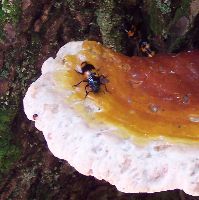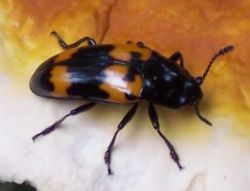| Cook
Forest Update |
Edward
Frank |
| May
24, 2004 10:59 PDT |
ENTS,
I made a trip to Cook Forest, PA yesterday. Someone needs to do
some
measuring in this amazing place. There are a number of species
in the park
that are not included in the Cook Forest Tall Tree List. I
decided to
measure a couple of those species to expand the list. I visited
the Paved
Trail o
measure a some trees found in an abandoned field along the far
edge
of the
trail:
Common Apple: 25.26 feet, pole and tape measurement
Hawthorne (sp) - [possibly a pear hawthorn?] - 20.14 feet, pole
and tape
measurement
 Hawthorne Leaf
Hawthorne Leaf
There are about a half dozen apple trees in this overgrown field
and maybe
a dozen or so hawthorns. These are the heights of largest
individuals of
each of these species. These may not be the tallest of these
species found
in the park, but they are measurements. One of the highlights of
the visit
today was the presence of several Red Efts in the field grass. A
second
neat thing found along the trail was a series of bracket fungi
growing on
some dead trees. Orange and red beetles were crawling all over
these
fungi. I haven't identified the beetle species yet.
 Beetle on fungi
Beetle on fungi
Assisting with the measurements were Brittany Aljoe, Ron Aljoe,
and Sue Aljoe.
Ed Frank
|
| RE:
Cook Forest Update |
Dale
J. Luthringer |
| May
24, 2004 11:39 PDT |
Ed,
Yes, you've scooped me on the apples and hawthorns... shucks.
Did you
get a circumference on those species? I think I know where a
Carpinus
caroliniana is that isn't on the list either. I can here Colby
telling
me to get out there and check out his Amelanchier sp. too. See,
I
haven't forgot...
Nice beetle pic. I've been told that beetle is supposed to have
some
type of symbiosis with hemlock varnish shelf. I haven't been
able to
take the time to look further into it though.
Dale
|
|
 (photo by Ed Frank)
(photo by Ed Frank)
The Varnish Shelf Fungus (Ganoderma tsugae) is found
typically on dead
hemlock trees and stumps. The orange and black beetle (Megalodacne heros) seen
here feeds on the fungus - photo by Ed Frank |
| Re:
Cook Forest Update |
Edward
Frank |
| May
25, 2004 05:24 PDT |
Michele,
A Red Eft is a small orange salamander with spots that is
commonly found in
wooded areas in this region of PA. It has a fairly wide
distribution
across the eastern US I believe.

Ed Frank
|
| Re:
Cook Forest Update- red efts |
SHAMR-@aol.com |
| May
25, 2004 09:56 PDT |
Red
efts have a colorful and interesting life cycle. After being
born they
emerge from the water very tiny and still showing their gills.
They grow up on
land where their bright orange coloring and red dots warn
predators that they
do not taste very good and have the added benefit of helping
hikers to avoid
stepping on them which can be very difficult after a rainfall
when they come out
from their hiding places in the hundreds. They eventually return
to water to
breed and live out the rest of their lives absorbing oxygen
through their skin
and occasionally coming to the surface for a gulp of air. At
this point they
are known as red spotted newts having traded in their orange
coloring for
olive green but retaining the red dots down their backs.
When I worked as a naturalist at a pond site in Vermont I used
to watch the
sunset every evening often while swimming or standing in the
pond. If I stood
still enough the newts would swim up to me and perch on my feet
perhaps for a
better view.
Tim |
|